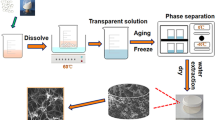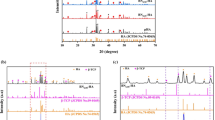Abstract
In the three-dimensional directly fabricating hydroxyapatite composite artificial bone scaffold process, the liquid bio-binder is sprayed on the surface of bioceramics powder layer. The spraying volume and the powder size directly influence the mechanical properties of the bone scaffold and the future biodegradation performance. When the size of powder is stable, the amount of binder spraying will directly affect the mechanical strength of bone scaffold. In order to figure out the solidification mechanism of α-n-butyl cyanoacrylate (NBCA) bio-binder on the hydroxyapatite (HA) powder layer, the molecular dynamics simulation method is applied to investigate the binding energy shifts between NBCA on HA crystallographic planes. The mechanical properties can be deduced from this methodology; furthermore, the Knoop identification experiments are used to investigate the effective elastic modules of pure HA system and HA/NBCA composite model. Both the simulation and the experiments results elucidate that HA (110) has the highest binding energy with NBCA as the high planar atom density and the mechanical properties of HA/NBCA mixed system are stronger than the pure HA system on three-dimensional crystallographic; in this sense, the bone scaffolds with different strengths could be fabricated by controlling various NBCA binders liquid doses on the surface of HA powder layers during the 3D printing process.








Similar content being viewed by others
References
Bellucci, Devis, Sola, Antonella, & Gazzarri, Matteo. (2013). A new hydroxyapatite-based biocomposite for bone replacement. Materials Science and Engineering C, 33(3), 1091–1101.
Wu, M., Dellacherie, E., Durand, A., et al. (2009). Poly(n-butyl cyanoacrylate) nanoparticles via miniemulsion polymerization (1): Dextran-based surfactants. Colloids and Surfaces B: Biointerfaces, 69(1), 141–146.
Fadaiea, P., Atai, M., et al. (2013). Cyanoacrylate–POSS nanocomposites: Novel adhesives with improved properties for dental applications. Dental Materials, 29(6), 61–69.
Tomlinson, S. K., Ghita, O. R., Hooper, R. M., & Evans, K. E. (2007). Monomer conversion and hardness of novel dental cements based on ethyl cyanoacrylate. Dental Materials, 23(7), 799–806.
Hong, Z., Zhang, P., He, C., Qiu, X., Liu, A., Chen, L., et al. (2005). Nano-composite of poly(L-lactide) and surface grafted hydroxyapatite: Mechanical properties and biocompatibility. Biomaterials, 32(26), 6296–6304.
Wang, Kefeng, Leng, Yang, et al. (2014). Molecular dynamics simulation of protein effects on interfacial energy between HA surfaces and solutions. Materials Letters, 123(15), 191–194.
Zhang, H. P., Lu, X., Leng, Y., Fang, L., Qu, S., Feng, B., et al. (2009). Molecular dynamics simulations on the interaction between polymers and hydroxyapatite with and without coupling agents. Acta Biomaterialia, 5(4), 1169–1181.
Prathab, B., Subramanian, V., & Aminabhavi, T. M. (2007). Molecular dynamics simulations to investigate polymer–polymer and polymer–metal oxide interactions. Polymer, 48(6), 409–416.
Pan, H. H., Tao, J. H., Wu, T., & Tang, R. K. (2006). Molecular simulation of water behaviors on hydroxyapatite crystal faces. Chinese Journal of Inorganic Chemistry, 22(8), 1392–1399.
Lai, Z. B., Wang, M., et al. (2014). Molecular dynamics simulation of mechanical behavior of osteopontin-hydroxyapatite interfaces. Journal of the Mechanical Behavior of Biomedical Materials, 36, 12–20.
Martinez de Arenazaa, I., Meaurioa, E., Coto, B., et al. (2010). Molecular dynamics modelling for the analysis and prediction of miscibility in polylactide/polyvinilphenol blends. Polymer, 51(19), 4431–4438.
Yang, W., Zhang, L., & Wu, L. (2009). Synthesis and characterization of MMA–NaAlg/hydroxyapatite composite and the interface analyse with molecular dynamics. Carbohydrate Polymers, 77(2), 331–337.
Kim, H., Camata, R. P., Chowdhury, S., & Vohra, Y. K. (2010). In-vitro dissolution and mechanical behavior of c-axis preferentially oriented hydroxyapatite thin films fabricated by pulsed laser deposition. Acta Biomaterialia, 6(8), 3234–3241.
Zamiri, A., & De, S. (2011). Mechanical properties of hydroxyapatite single crystals from nanoindentation data. Journal of the Mechanical Behavior of Biomedical Materials, 4(2), 146–152.
Gross, K. A., & Rodríguez-Lorenzo, L. M. (2004). Sintered hydroxylfluorapatites. Part II: Mechanical properties of solid solutions determined by microindentation. Biomaterials, 25(7), 1385–1394.
ASTM E384-99. (1984). A Standard test method for microindentation hardness of materials.
Marshall, D. B., Noma, T., & Evans, A. G. (1982). A simple method for determining elastic-modulus–to-hardness ratios using knoop indentation measurements. Journal of the American Ceramic Society, 65, C175.
Acknowledgments
This project is sponsored by the National Natural Science Foundation of China (Grant No. 51175432), the Fundamental Research Funds for the Central Universities (Grant No. 3102014JCS05007), the Doctor Special Science and Technological Funding of the China Ministry of Education (Grant No. 20116102110046), and the graduate starting seed fund of Northwestern Polytechnical University (Grant No. Z2014037).
Author information
Authors and Affiliations
Corresponding author
Rights and permissions
About this article
Cite this article
Wang, Y., Li, X., Wei, Q. et al. Study on the Mechanical Properties of Three-Dimensional Directly Binding Hydroxyapatite Powder. Cell Biochem Biophys 72, 289–295 (2015). https://doi.org/10.1007/s12013-014-0452-0
Published:
Issue Date:
DOI: https://doi.org/10.1007/s12013-014-0452-0




